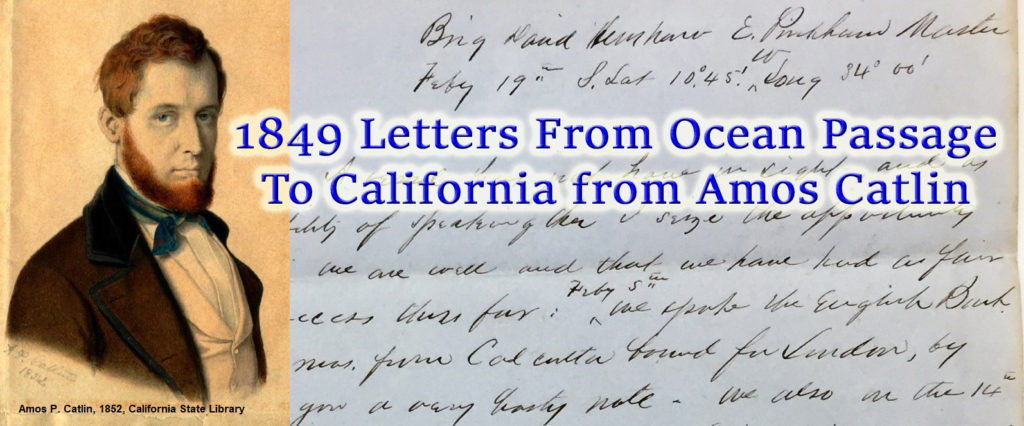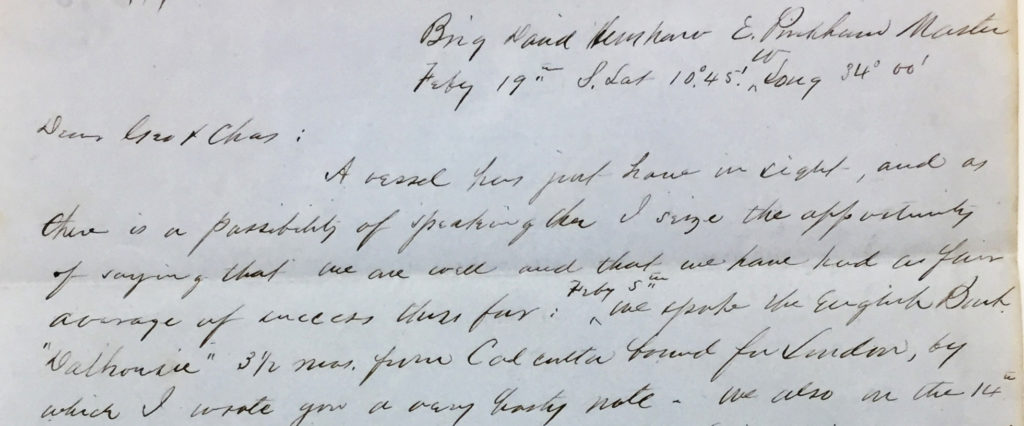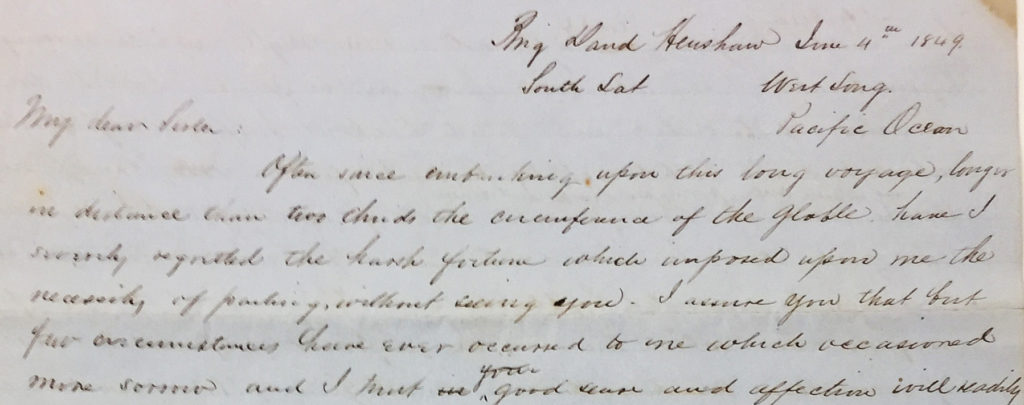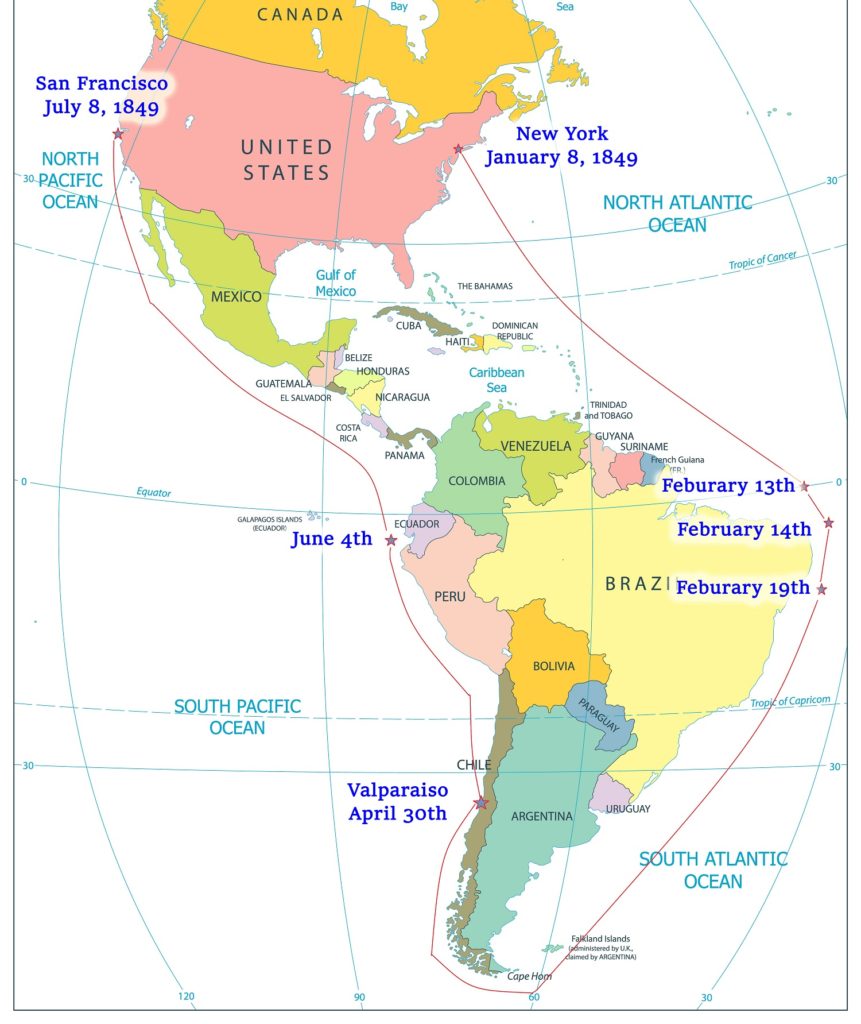Amos Catlin joined the Gold Rush to California in 1849. He traveled from New York to San Francisco aboard the Brig David Henshaw. While he kept a journal, it has not been found in any of the documents scattered across multiple archives. What has survived are two letters he wrote while at sea to family members back in New York.

The two letters differ in tone and substance. However, they each give a glimpse of the 7-month ocean voyage around Cape Horn, South America. Amos Catlin’s decision to join the Gold Rush seemed somewhat out of character for a 26-year-old man who had spent his adult life studying and then practicing law in New York. These letters exhibit his detailed observations that would be reflected in letters Amos wrote later while living in California.
In 1848, Amos went into a partnership with his cousin and fellow attorney George Catlin in New York. From letters written by George it seems George, his brother Charles, and Amos had plans for some sort of investment in California. Both George and Charles Catlin wrote several letters of introduction, for Amos, to men they knew in California.
Gold Rush Ocean Voyage Letters From Amos Catlin, 1849
Amos’ first letter to George and Charles is more professional and gives details of the ship’s progress. The second letter was written to Amos’ sister Jane DuBois. This second letter is more personal and expressive over the hardships he experienced on the long voyage.
Amos departed New York on January 8, 1849. Abram Van Demark, who Amos knew from residing in Ulster County, New York, was on the ship. Amos and Abram would mine together at Mormon Island, California. The Brig David Henshaw had 15 passengers and a crew of 12. Captain Pinkham was at the helm of the ship. The Henshaw arrived in San Francisco on July 8, 1849.
Below are my transcriptions of the letters. Fortunately, Amos had very good penmanship and most of the words are easy to decipher. There is only light editing such periods at the end of sentences. Where a word was indecipherable, I have marked it (sp.) The letters are from the Huntington Library, Catlin Addenda Box 1.
Letter to George and Charles Catlin

Brig David Henshaw E. Pinkham Master
February, 19th, S. Latitude 10° 45’, Longitude 34° 00’
Dear Geo & Char:
A vessel has just have in sight, and as there is a possibility of speaking her I seize the opportunity of saying that we are well and that we have had a fair average of success thus far: Feby 5, we spoke the English Bark “Dalhousie” 3 ½ neas.(sp) from Calcutta bound for London, by which I wrote you a very hasty note. We also on the 14th instant spoke the U.S. Man of War Cutter Ewing, in S. Lat. 2° 09’. W Long 31° 00’ by which opportunity I wrote you more at length: The “Ewing” left N.Y. on the 10th inst bound for California: she intended to touch at Rio from which place our letters will have a fair chance of reaching you. We were in sight of the “Ewing” 5 days after which she left us. The day she spoke us was a calm and I had the pleasure of spending a part of the afternoon in her elegant cabin where I learned from the Commander Leuit Bartlet(sp) that the main object of his voyage was to survey the coast of the Pacific.
We also on the 12th instant spoke the Boston Pilot boat “Anonyroua”(sp) 75 tons berither(sp) only 24 days from Boston bound for San Francisco: she looked more like a Hudson River pleasure boat than a California Gold hunter:
By the Ewing I also wrote to my father. Will you be kind enough to let him know that I have written- I do not expect more than one of six of my letters will…
Page 2…ever reach their destination. We had an excellent run from N.Y. for about 10 days during which time we made sea 1500 miles- she there, unfortunately, in the very trade regions encountered strong S.E. winds for 12 days successively during which we did not make 200 miles. Since then we have had on the whole tolerably good luck, but not enough to make good our loss with the head winds.
I have not time to give you the particulars of the voyage now. The Ewing letter is more full.
I hope to find letters for me at San Francisco. All intelligence which I find from you, when I arrive there will be interesting and valuable.
By our calculations, we find that today we are directly under the sun, that at the moment (3. P.M. ship’s time) we have passed the eclipse and are bearing the sun to the North, we crossed the equator on the 13th inst at 10 ½ o’clock A.M. precisely with a most splendid squall, of 3 hours duration.
Letter to Jane DuBois
The second letter was to Amos’ sister Jane DuBois. Amos obviously felt comfortable conversing with his sister on a variety of topics including his emerging homesickness, the harrowing weather they had encountered, and women’s fashion in Valparaiso.

Brig David Henshaw, June 4th 1849
South Lat ___ West Long___ Pacific Ocean
My dear Sister:
Often since embarking upon this long voyage, longer in distance than two thirds the circumference of the globe, have I severely regretted the harsh fortune which imposed upon me the necessity of parting, with seeing you. I assure you that but few circumstances have ever occurred to me which occasioned more sorrow and I trust in your good sense and affection will readily find our excuse for me when you consider the circumstances, the Captain of the Brig ready to sail and daily announcing his determination to so immediately, the obstructed navigation of the River and your unexpected absence when I expected to find all at home.
Express my regrets at their misfortune to your husband and to little Ricco(sp) who perhaps will be able to understand then before ever I shall see him again, and to all my friends upon whom I should have called had it been possible.
I shall mail this letter to you by the first port from San Francisco at which port I confidently expect to arrive in about 20 days. I am now with about 150 miles of the equator and will tomorrow or next day cross it for the second time. I consider the perils of the voyage as past as for some time past we have sailed, and for the remainder of the voyage expect to sail through peaceful seas with moderate winds.
It is from its uniformly moderate character that the ocean through the grates(sp) note its name of “Pacific”.
The passage round Cape Horn was long cold and severe for 30 days we encountered head winds attended with incessant and terrible gales and one hurricane from which we escaped without serious loss. While off the River Platte on the east coast of South America we were caught in what is a common thing in that place a “Pampero” a hurricane of the worst description & which has been known to blow whalers ashore. It continued three days during which time the huge seas which struck and broke over our ship carried away the quarter boat flying jib boom and head sails stove the bulwark and the galley with its cooking apparatus so that we had to live on raw…
Page 2… ham and sea biscuit until the galley could be repaired. One night, while tossing in our bunks, a sea which struck on the quarter burst the after door of the cabin and filled it about half full of water which had to be bailed out by the bucket full. One of my trunks, which contained my best clothes and linen, was soaked through and a lot of seidbts(sp) pouches exploded salt water stains linen and silk with a yellowish color which can only be eradicated by bleaching. This is about the sum of my disasters which are very insignificant compared to those of some others bound on the who started from N.Y. on the same voyage. One vessel, the Hackstaff(sp), had her Captain and five men washed overboard. The Architect from N.O. lost eight passengers with cholera. The “Mary and Adeline” which we spoke near the Horn had one man washed overboard and it is reported that on or two vessels were lost of the Horn, and one or two of the ships have been so badly damaged that they were compelled to put into the nearest port unable to passage(sp) further.
I consider myself extremely fortunate in having taken passage on board of a staunch vessel with a cautious Captain and have often felt however unworthy of it, that, through the terrible storms I have passed that we were are under the protection of a kind Providence. I have kept a journal of the voyage which I hope to send you one day. I have twice written to father and George Catlin. Once by the US Man of Way “Ewing” While on the equator in the Atlantic which intended to ship at Rio Danario [de Janeiro] and once from Valparaiso at which port we stopped for water on the 30th of April.
There were about a dozen American, California bound vessels in Valparaiso harbor and it was computed that there was 1200 Yankees or Yankee doodleors as the Native called us in the City. American ships loaded with passengers were coming in and going out daily. I have not shall not give you a description here of the city or its inhabitants, but you may readily imagine that every thing appeared strange to me. I made the best use of the four days that we stopped there to eat fresh provisions and see what I could see, in order….
Page 3…balance the affects of having lived on salt grub with ever once seeing land for 112 days. I rode on a donkey (the usual mode of conveyance there) nine miles into the country and saw plenty of beautiful copper colored Spanish women and magnificent vineyards. The people were very hospitable and polite. They are descended from the ancient Spaniards who conquered and settled south America and they speak the Spanish language which I have studied on my passage, and could muster enough of it to maintain a conversation. The ladies of all classes were no hats, but with their shawl cover their heads from which it drops over their shoulders and is wrapped gracefully around their form. I saw them thus(sp) in the church, theatre and in the public streets. The dress otherwise is much like that of American ladies, except that there is no gaudy(sp) colors or flaring(sp) cut, being genuinely of plain cloak(sp) cut close in the neck and falling to the ground. The men all wear the “poncho” or Spanish cloak which seems to be a square piece of cloth or more or less costly and orraserated(sp) with a hole in the outer chroungto(sp) which the head is thrust – with each of the four corners hanging down on the right and left side and front and rear.
I hope to find your letters at San Francisco and learn that you are all well. Do not neglect to write to me and tell me all the news about my acquaintances in Ulster Co. who are married and who are going to be etc. Order (I believe that is the word) your husband to write also. Tell me all you have heard from William [brother of Amos and Jane] together with every piece of news you can think of. Abraham has grown so fat you would scarcely recognize him. He begs to be remembered to all, to his Rundout [RedHook?] friends, to Mr. J. Youngman, to whom please also give my respect. Enclosed I send you a map I have made of our passage round Cape Horn one of the most difficult points in the world to double from the Atlantic side as westerly winds and a strong current persist nearly the whole year. Our vessel gained every inch by beating dead to windward. The map will not present the multitudinous windings of our course but it will show where we were and what we had gained or lost at 12 o’clock each day.
Page 4… You will perceive that I was several times some 1600 miles neared the S Pole than you are to the North Pole. In less than six months I have experienced two winters and two summers having left N.Y. in the middle of winter passed over the equator and under the sun’s eclipse in the Atlantic then through the snow storms off Cape Horn and are now again nearly under the sun.
Map of Ocean Voyage from New York to California
Below is a map of Amos’ voyage to California. The points are locations noted in his letters. It is possible that the Brig David Henshaw stopped at ports other than Valparaiso, but none are mentioned in Amos’ correspondence to his family.

Subsequent letters from Amos to his family in New York would indicate that at some point he was considering moving back to New York. It would never happen. After mining for gold at Mormon Island, Amos would organize and manage the construction of water projects in California. Amos would eventually return to law full time, was elected to the California Senate and Assembly, and was elected a Sacramento Superior Court Judge. In 1854, Amos, as a California State Senator, sponsored the legislation to permanently move the state’s capital to Sacramento. Amos died in Sacramento on November 5, 1900.


